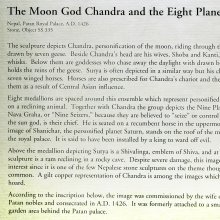Paran, Parāṅ, Paraṇ, Paraṉ: 8 definitions
Introduction:
Paran means something in Hinduism, Sanskrit, Hindi, biology, Tamil. If you want to know the exact meaning, history, etymology or English translation of this term then check out the descriptions on this page. Add your comment or reference to a book if you want to contribute to this summary article.
Images (photo gallery)
Biology (plants and animals)
Source: Wisdom Library: Local Names of Plants and DrugsParan in the Lahaul language is the name of a plant identified with Jacobaea nudicaulis (Buch.-Ham. ex D.Don) B.Nord. from the Asteraceae (Sunflower) family having the following synonyms: Senecio nudicaulis, Senecio esquirolii, Senecio denudatus. For the possible medicinal usage of paran, you can check this page for potential sources and references, although be aware that any some or none of the side-effects may not be mentioned here, wether they be harmful or beneficial to health.
Source: Google Books: CRC World Dictionary (Regional names)Paran in India is the name of a plant defined with Senecio nudicaulis in various botanical sources. This page contains potential references in Ayurveda, modern medicine, and other folk traditions or local practices It has the synonym Jacobaea nudicaulis (Buch.-Ham. ex D. Don) B. Nord. (among others).
Example references for further research on medicinal uses or toxicity (see latin names for full list):
· Prodromus Florae Nepalensis (1825)
· Numer. List (3132)
· Journ. de Bot. (1894)
· Prodr. (DC.) (1838)
· Bulletin de la Société Botanique de France (1893)
· Feddes Repertorium Specierum Novarum Regni Vegetabilis (1912)
If you are looking for specific details regarding Paran, for example health benefits, pregnancy safety, side effects, diet and recipes, extract dosage, chemical composition, have a look at these references.

This sections includes definitions from the five kingdoms of living things: Animals, Plants, Fungi, Protists and Monera. It will include both the official binomial nomenclature (scientific names usually in Latin) as well as regional spellings and variants.
Languages of India and abroad
Sanskrit dictionary
Source: Cologne Digital Sanskrit Dictionaries: Monier-Williams Sanskrit-English Dictionary1) Parāṅ (पराङ्):—[from parāñc] a ind. outwards, towards the outer world, [Kaṭha-upaniṣad; Bhāgavata-purāṇa]
2) [from parāñc] b in [compound] for, rāñc.
3) Parāṇ (पराण्):—1. parāṇ (parā-√an) [Parasmaipada] parāṇiti ([Desiderative] parāṇiṇiṣati), [Pāṇini 8-4, 19 etc.]
4) 2. parāṇ mfn., [ib. 20.]
[Sanskrit to German]
Sanskrit, also spelled संस्कृतम् (saṃskṛtam), is an ancient language of India commonly seen as the grandmother of the Indo-European language family (even English!). Closely allied with Prakrit and Pali, Sanskrit is more exhaustive in both grammar and terms and has the most extensive collection of literature in the world, greatly surpassing its sister-languages Greek and Latin.
Hindi dictionary
Source: DDSA: A practical Hindi-English dictionaryParan in Hindi refers in English to:—(nm) the first meal taken after a fast; passage; —[karana] to take the first meal after a fast; to pass..—paran (पारण) is alternatively transliterated as Pāraṇa.
...
Tamil dictionary
Source: DDSA: University of Madras: Tamil LexiconParaṇ (பரண்) noun cf. bharaṇa. [Malayalam: paraṇ.]
1. Watch tower; காவல்மேடை. [kavalmedai.]
2. Rack over a fireplace, loft under the roof of a house; மேற் றட்டு. [mer rattu.]
3. Upper storey; மச்சு. சூழ்பரண்மேல் போர்கடா வரசர் [machu. suzhparanmel porkada varasar] (நாலாயிர திவ்யப்பிரபந்தம் திருவாய்மொழி [nalayira thivyappirapandam thiruvaymozhi] 8, 4, 1).
--- OR ---
Paraṉ (பரன்) noun < para.
1. God, as the Supreme Being; கடவுள். பரனே . . . வரனே [kadavul. parane . . . varane] (நாலாயிர திவ்யப்பிரபந்தம் பெரியதி. [nalayira thivyappirapandam periyathi.] 7, 7, 4).
2. Foreigner, stranger, alien; அன்னியன். [anniyan.]
3. cf. apara. (Śaiva Philosophy) Individual soul; சீவான்மா. ஏரியல் பரன் பசுவென்றறி [sivanma. eriyal paran pasuvenrari] (ஞானாமிர்தம் [gnanamirtham] 5).
Tamil is an ancient language of India from the Dravidian family spoken by roughly 250 million people mainly in southern India and Sri Lanka.
Nepali dictionary
Source: unoes: Nepali-English DictionaryPaaran is another spelling for पारण [pāraṇa].—[pāraṇa / pāraṇā] n. 1. eating and drinking after a fast; 2. satisfaction; gratification; 3. completion; ending; accomplishment; 4. reading or reciting;
Nepali is the primary language of the Nepalese people counting almost 20 million native speakers. The country of Nepal is situated in the Himalaya mountain range to the north of India.
See also (Relevant definitions)
Starts with (+239): Para-naricakotaran, Parakara, Parakata, Parakpushpi, Paramcata, Paramciya, Paramciya, Paramdama, Paramdhama, Paramdhamarupa, Paramgama, Paramgamana, Paramgamana, Paramgamate, Paramganavirati, Paramgane, Paramgate, Paramgaya, Paramgiakkihullu, Paramgicekke.
Ends with (+7): Acamparan, Acaraparan, Acuyaparan, Anniyaparan, Atiparan, Camparan, Camputarparan, Caparan, Cirparan, Ekamparan, Kantaparan, Karparan, Kuruparan, Nana-kuruparan, Nanaparan, Parama-paramparan, Paramparan, Paraparan, Pukaipparan, Samparan.
Full-text (+34): Paranc, Pukaipparan, Paranmukham, Paranmukhatva, Paranmukhabhuta, Paranmukhata, Paranmukhikri, Paranmukhaya, Paranavritta, Paranmukhibhu, Paranmanas, Parantapan, Parana, Paran Mukha, Titiparan, Aparanmukha, Atiparan, Nanaparan, Parananti, Erumatam.
Relevant text
Search found 10 books and stories containing Paran, Parāṅ, Parāṇ, Paraṇ, Paraṉ, Paaran; (plurals include: Parans, Parāṅs, Parāṇs, Paraṇs, Paraṉs, Paarans). You can also click to the full overview containing English textual excerpts. Below are direct links for the most relevant articles:
Tiruvaymoli (Thiruvaimozhi): English translation (by S. Satyamurthi Ayyangar)
Pasuram 3.3.8 < [Section 3 - Third Tiruvaymoli (Olivu il kalam)]
Pasuram 4.10.3 < [Section 10 - Tenth Tiruvaymoli (Onrum-tevum, ulakum)]
Pasuram 1.1.11 < [Section 1 - First Tiruvaymoli (Uyarvu ara Uyar Nalam)]
Garga Samhita (English) (by Danavir Goswami)
Verse 6.2.12 < [Chapter 2 - Residence in Śrī Dvārakā]
Chaitanya Bhagavata (by Bhumipati Dāsa)
Verse 2.6.172 < [Chapter 6 - The Lord’s Meeting with Advaita Ācārya]
Shrimad Bhagavad-gita (by Narayana Gosvami)
Verse 9.21 < [Chapter 9 - Rāja-guhya-yoga (Yoga through the most Confidential Knowledge)]
Early Chola Temples (by S. R. Balasubrahmanyam)
Temples in Nangavaram (about the 10th year) < [Chapter X - Historical Survey]
Temples in Tirukkalittattai < [Chapter II - Temples of Parantaka I’s Time]
Chola: Vijayalaya < [Chapter XIV - Conclusion]
Later Chola Temples (by S. R. Balasubrahmanyam)
Temples in Udaiyalur < [Chapter II - Temples of Kulottunga I’s Time]
